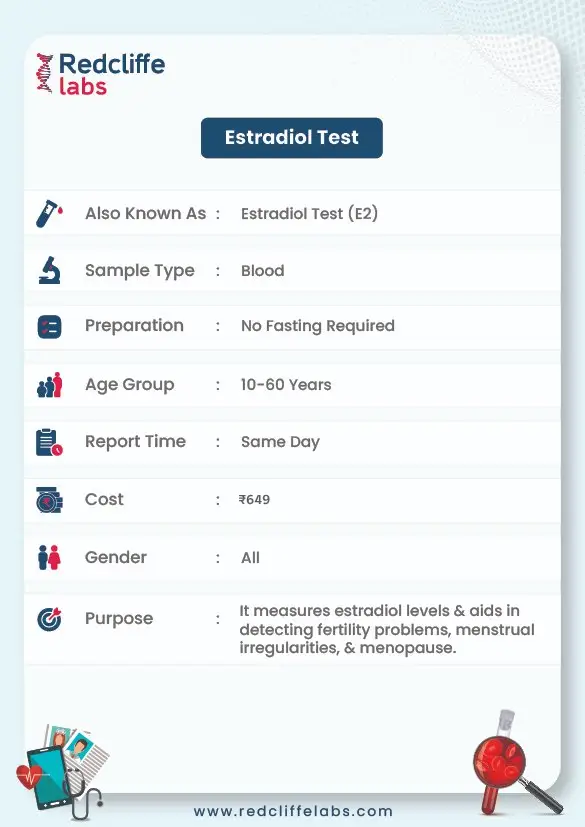The Estradiol Test measures blood levels of estradio...Read more
Blood
Unlock special
discount on
this package
Login to Unlock 🔓
Test Criteria
Also Known As
oestradiol, E2, estrogenBooking Benefits Unlocked Worth FREE 799

Report Consultation

Diet Plan
*Available once your report is generated.
At Redcliffe Labs, we have a single goal: to give India its right to quality diagnostics.
Customers served
Tests Processed Everyday
Cities
Collection Centres
World Class In-house Labs
Home Collection Experts
1 Test Parameters
Estradiol (E2)
1 PARAMETER INCLUDED
1 PARAMETER INCLUDED
- Estradiol (E2)
Helps you know your test better
Who all are eligible for this test?
- Women over 45 old (pre-menopause or late menopause).
- Adolescent girls.
- Males.
- Women with symptoms of ovarian tumors, abnormal bleeding during periods, lack of menstrual cycle
Why take estradiol test ?
- This test tells you about the menopause stages, fertility, and puberty.
- It detects how well the ovaries, adrenal glands, and testes are working
What are the benefits of estradiol test?
- Helps doctors suggest hormonal replacement therapy in case of any imbalance.
- Evaluates any menstrual problems in women and adolescent girls (missing periods or abnormal bleeding).
- Helps to reduce menopausal symptoms
Top Booked Health Checkup Packages
Parameters 94
Parameters 96
Parameters 96
Parameters 90
Parameters 96
Helps you know your test better
Q. What Is An Estradiol Test?
Q. How Much Is Estradiol Level Normal?
Q. What Happens During Estradiol Test, Or Does It Require Any Special Preparations?
Q. Are There Any Risks Associated With The Test?
Verified by Medical Expert

WRITTEN BY
Sheena Mehta

MEDICALLY REVIEWED BY
Dr. Pradeep Lodha
Table of Content
Introduction to Estradiol Test
Estradiol is a sex hormone that plays a vital role in the development and functioning of the female reproductive system. It promotes the growth of the uterus, regulation of the menstrual cycle, and development of secondary sexual characteristics. In males, estradiol is produced in smaller amounts and is important for bone health and other functions. The estradiol test measures the amount of hormone estradiol in your blood, which is helpful for bone and joint health in females, and assesses how fat is distributed in the body.
In females, estradiol levels fluctuate throughout the menstrual cycle. The levels are usually highest around ovulation and decrease during other cycle phases. The estradiol test assesses disorders like polycystic ovary syndrome (PCOS), ovarian tumors, and hormone imbalances.
Your doctor might recommend a serum estradiol test if you face abnormal menstrual periods, abnormal vaginal bleeding, and infertility symptoms. Take the estrogen hormone test with Redcliffe Labs. The professional provides the best diagnostic services. The phlebotomist will come to your place to collect the sample. The timely estradiol testing can save you from severe health complications. So book your Estradiol test today!
Test Details in Brief
|
Also Known As |
Estradiol Test (E2) |
|
Purpose |
It measures estradiol levels & aids in detecting fertility problems, menstrual irregularities, & menopause. |
|
Preparation |
Do not take any over-the-counter medicine without confirming with your Doctor. |
|
Fasting |
No Fasting Required |
|
Get Reports Within |
Within 12 hours |
|
Cost |
INR 649 |

Importance of Normal Estrogen Levels
Monitoring and maintaining estrogen levels promote overall well-being and vitality. There are three primary types of estrogen hormones:
Estradiol (E2):
- Estradiol is the most abundant and potent form of estrogen in the body.
- Estradiol plays a crucial role in developing and maintaining the female reproductive system, including regulating the menstrual cycle, supporting pregnancy, and promoting the growth of secondary sexual characteristics.
- It also contributes to bone health, cardiovascular function, and other physiological processes.
Estrone (E1):
- Estrone is another important form of estrogen.
- It is produced in various tissues, including the ovaries, adrenal glands, and fat cells.
- Estrone levels increase after menopause when ovarian estrogen production declines, and it becomes the predominant estrogen in postmenopausal women.
- It contributes to bone health and other functions but is less potent than estradiol.
Estriol (E3):
- Estriol is the least potent form of estrogen.
- It is mainly produced during pregnancy by the placenta.
- Estriol levels rise significantly during pregnancy, often used as a marker of fetal well-being.
- While estriol has weaker estrogenic effects compared to estradiol and estrone, it still plays a role in supporting pregnancy and has potential protective effects on certain tissues.
These three estrogen hormones influence various physiological processes, including reproduction, bone health, cardiovascular function, and more. Their levels fluctuate throughout life, with variations during puberty, the menstrual cycle, pregnancy, and menopause. Maintaining a balanced ratio of these estrogen hormones is crucial for overall health and well-being.
Purpose of the estradiol blood test
The estradiol test measures estradiol levels, a type of estrogen hormone, in the blood. Estradiol plays a crucial role in developing and maintaining the female reproductive system and has important effects on males. The estrogen hormone test is primarily used to:
- Assess Reproductive Health: In females, estradiol levels fluctuate during the menstrual cycle and are used to assess the health and function of the ovaries. Monitoring estradiol levels can help diagnose conditions like polycystic ovary syndrome (PCOS), ovarian tumors, and other reproductive health disorders.
- Monitor Menopause: During menopause, a woman's estrogen production decreases. Estradiol levels can help determine whether a woman is nearing menopause or has already reached this stage.
- Evaluate Fertility: Estradiol levels check the follicle-stimulating hormone (FSH) to evaluate a woman's fertility status and to determine the causes of infertility.
- Hormone Replacement Therapy: For women undergoing hormone replacement therapy (HRT) to manage menopausal symptoms, estradiol levels are monitored to ensure that the therapy effectively maintains hormonal balance.
- Assess Hormonal Imbalances: Elevated or decreased estradiol levels can indicate hormonal imbalances in males and females. In males, estradiol is produced in small amounts and is important for bone health, but elevated levels might indicate conditions like obesity or certain types of tumors.
- Evaluation of Puberty: In children and adolescents, estradiol levels can be used to assess the onset of puberty and monitor the development of secondary sexual characteristics.
Preparation of estradiol blood test
Preparation for an estradiol test involves a few general guidelines:
- Consult Your Healthcare Provider: Consult your healthcare provider before undergoing any medical examination. They will provide specific instructions based on your medical history, current health status, and the test's purpose.
- Fasting: No fasting is not required for an estradiol test.
- Medications: Inform your healthcare provider about any medicines, supplements, or hormone therapies you are taking.
- Stress and Exercise: Avoid vigorous exercise and manage stress before the test.
- Hydration: Stay well-hydrated before the test, as dehydration can affect blood test results.
- Alcohol and Caffeine: Limit alcohol and caffeine intake before the s estradiol test, as these substances can influence hormone levels.
- Follow Instructions: Always follow any specific instructions from your healthcare provider or the laboratory. They might have personalized recommendations based on your health status and the test's purpose
The procedure of the Estradiol test
The estradiol test is a blood test that measures estradiol levels, a type of estrogen hormone, in your bloodstream. The healthcare professional will clean the area with antiseptic to prevent infection. A sterile needle will be inserted into the vein to draw blood.
After the blood is collected, a cotton ball or gauze pad will be placed on the puncture site. The collected blood sample will be sent to a laboratory for analysis. The laboratory technicians will measure the levels of estradiol in your blood.

What do the estradiol test reports indicate?
The interpretation of an estradiol test report depends on several factors, including the reference ranges provided by the laboratory, your age, sex, menstrual status (for females), and the reason for the test. The s estradiol test measures the levels of the estrogen hormone estradiol in your blood. Here's what the results might indicate:
- Fertility and Reproductive Health: In females, monitoring estradiol levels alongside other hormones like follicle-stimulating hormone (FSH) can help assess fertility and reproductive health. High levels might indicate conditions like polycystic ovary syndrome (PCOS), while low levels might suggest a problem with ovarian function.
- Menopause: Estradiol levels decrease significantly during menopause. Low estradiol levels in postmenopausal women are expected and are a marker of ovarian function decline.
- Hormone Replacement Therapy (HRT): For women undergoing hormone replacement therapy (HRT) for menopausal symptoms, the goal is to restore estradiol levels to a range that alleviates symptoms without increasing health risks.
- Hormonal Imbalances: High estradiol levels in males might indicate hormonal imbalances, such as obesity or certain tumors. High levels outside the normal range might indicate conditions like ovarian tumors in females.
- Puberty: In children and adolescents, estradiol levels rise during puberty and contribute to the development of secondary sexual characteristics. Monitoring these levels can help assess the progression of puberty.
What is estradiol's normal range?
The normal range for estradiol levels can vary based on several factors, including age, sex, menstrual status (for females), and the laboratory reference values used.
- Menstruating women's normal range is 15 to 350 (pg/mL).
- Postmenopausal women normal range :(<10 pg/mL).
- Men: between 10 and 50 pg/ml
Why do I need an estradiol test?
Healthcare professionals may recommend an estradiol test for a variety of reasons. Here are some common reasons why you might need an estradiol test:
- Assessing Reproductive Health and Fertility: The estradiol test assesses ovarian function and fertility in females. It helps determine whether you are ovulating regularly and your reproductive system functions correctly.
- Monitoring Menopause: During menopause, estrogen levels, including estradiol, decline. Monitoring estradiol levels can help confirm menopause and provide insights into hormone replacement therapy (HRT) options.
- Hormone Replacement Therapy (HRT): For postmenopausal women taking HRT, the test helps monitor whether hormone levels are effectively balanced to alleviate symptoms while minimizing health risks.
- Evaluating Hormone Therapy: Individuals undergoing gender-affirming hormone therapy may have estradiol levels monitored to ensure that hormonal changes are consistent with their transition goals.
- Assesses Puberty: In children and adolescents, the test can help evaluate the timing and progression of puberty, as estradiol plays a role in the development of secondary sexual characteristics.
- Monitoring Hormonal Health: Estradiol levels can provide insights into overall hormonal health in both males and females. Abnormal levels might indicate health conditions such as hormone-producing tumors.
- Infertility Evaluation: Estradiol levels and other hormone tests can help diagnose potential causes of infertility and guide treatment.
- Bone Health Assessment: Estradiol is important for bone health. Low levels indicate a risk of bone density loss or osteoporosis.
- Assessing Tumor Activity: In certain types of tumors, such as estrogen-sensitive breast cancer, monitoring estradiol levels can help determine tumor activity and response to treatment.

What are the risks associated with an estradiol test?
An estradiol test is a simple and low-risk blood test. Here are some risks of taking an estradiol test:
- Pain or Discomfort
- Bruising or Hematoma
- Fainting or Dizziness
- Allergic Reaction
- Nerve Damage
- Hematoma Formation
- Vasovagal Response
If you have any concerns about the risks associated with the estradiol test, don't hesitate to discuss them with a healthcare professional. They can help you throughout the procedure as comfortably and safely as possible.
Estradiol Test price at Redcliffe Labs
The Estradiol test is available at Redcliffe Labs for just INR 649. If your healthcare professional has advised you to undergo this test, we are your best option. Our commitment is to offer top-notch diagnostic services at affordable rates. Our skilled phlebotomist will conveniently visit your home to collect the sample, ensuring a hassle-free experience. We take pride in assuring you of our exceptional services and expertise. So why are you still waiting? Take a step forward and book your appointment online today!
Some Other Tests/Packages Related to the Estradiol Test That You Can Book with Redcliffe Labs
| Tests/Packages | Price in INR |
| OvaScreen Test | ₹1400 |
| OvaScreen Advanced Panel | ₹2499 |
| Body Builder Hormones Profile | ₹3199 |
| Anti Aging Profile (Male) | ₹4999 |
| Anti Aging Profile (Female) | ₹5199 |
Conclusion
The estradiol test helps assess both male's and females' hormonal balance and reproductive health. By measuring estradiol levels, the serum estradiol test provides insights into various aspects of health, including fertility, menopause, puberty, and overall hormonal well-being.
Whether it's menstrual cycle irregularities or monitoring hormone replacement therapy, the estradiol test helps to understand the body's hormonal dynamics. Consult with your healthcare provider and take the estradiol blood test today!